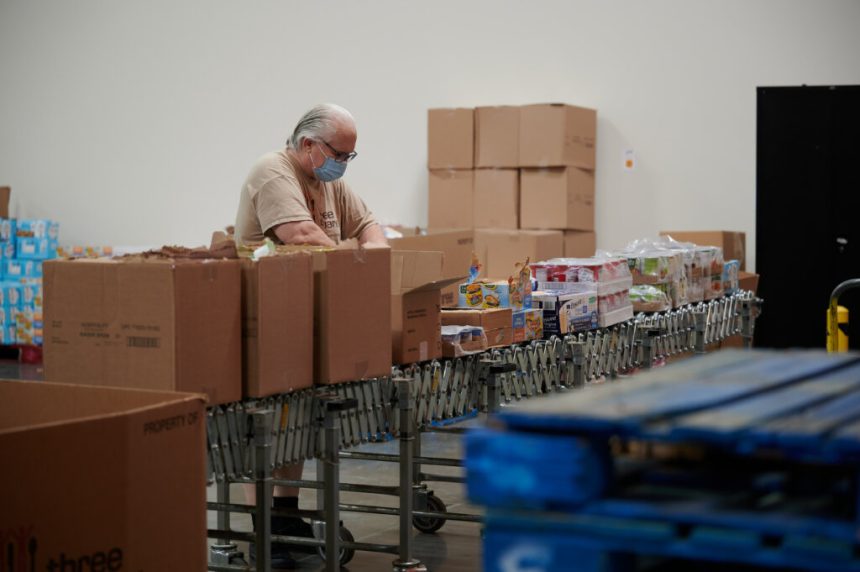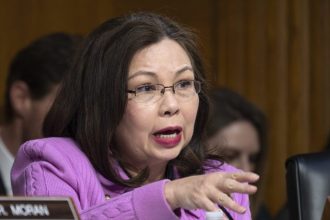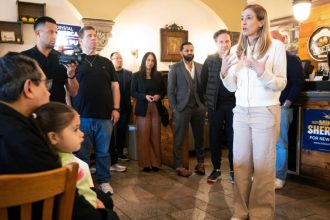A volunteer packs food at Three Square Senior Hunger Campus. (Photo courtesy Three Square of Southern Nevada)
The State of Nevada plans to quickly funnel $38.8 million toward local food banks in hopes fewer people will go hungry next month when $90 million in federally funded “food stamps” are not delivered to low-income people and families.
A memo released by Republican Gov. Joe Lombardo’s office Monday announced a $38.8 million “Food Insecurity Nevada Plan” that will prop up local food banks, which are expected to see a flood of demand from the approximately half a million residents who currently receive benefits through the Supplemental Nutrition Assistance Program, better known as SNAP or by the antiquated term food stamps.
SNAP benefits are 100% federally funded. Nevadans receive approximately $90 million in SNAP benefits each month.
Because of the federal government shutdown, and because of a USDA decision to not follow its own contingency plan outlining the use of nearly $6 billion in emergency funds to keep providing food assistance, SNAP benefits are expected to come to a screeching halt for more than 42 million people nationwide.
The “Food Insecurity Nevada Plan” proposes taking $30.2 million from the Interim Finance Committee’s contingency fund, which lawmakers typically use to pay for unexpected expenses like lawsuit settlements or overtime salaries. Another $8.6 million will be reallocated from other already approved projects, though the details of that are not yet public.
Lombardo’s memo says he will engage the Nevada National Guard “to assist with food distribution to those in need.” To that end, he is requesting legislators approve $200,000 for their pay.
The Nevada Board of Examiners — composed of the governor, Democratic Attorney General Aaron Ford, and Democratic Secretary of State Cisco Aguilar — is scheduled to meet Wednesday morning to consider the IFC contingency fund transfer and National Guard salaries.
The Interim Finance Committee is scheduled to meet Thursday afternoon to give final approval. The agenda of that meeting had not been posted online as of late Monday.
Nevada’s planned response is similar to what’s being done by its neighbor to the west. California Gov. Gavin Newsom last week announced the state would fast track $80 million in funding to food banks and deploy its national guard to assist at food banks.
Several California food banks declined that help, citing community fear.
Lombardo in August authorized the use of the Nevada National Guard to support U.S. Immigration and Customs Enforcement. Officials have said that work is administrative in nature and only involves 1% of the state’s guard. Still, distrust within immigrant communities is high.
The “Food Insecurity Nevada Plan” is expected to boost local food banks across the state.
“The resources provided through these community programs are intended to make sure that no family goes hungry during this crisis,” said Lombardo spokesperson Elizabeth Ray in an emailed statement to the Nevada Current.
Key details are unknown, such as what time period the $38.8 million will be used over, and to what extent the food banks have capacity to scale up their services.
Even before the federal government shut down on Oct. 1 food banks were already struggling to meet increased demand. They have also been dealing with earlier cuts to federal grant programs.
SNAP benefits are distributed via an electronic benefits transfer (EBT) system, in which recipients get benefits deposited on what is effectively a debit card that can be used to purchase items in stores. Best efforts notwithstanding, food banks will not be able to fill the void left by discontinued SNAP funding of EBT cards.
A spokesperson for Food Bank of Northern Nevada told the Current the food bank is “working on aggressive food sourcing through donations and purchased food” but acknowledged that, even with additional state money, it will be an impossible task to immediately help each of the 77,008 people in Northern Nevada set to lose their SNAP benefits on Saturday.
“For every meal that we provide, SNAP provides nine, making it impossible for us to scale up our operations to that level,” said spokesperson Jocelyn Lantrip in an email. “We do want our communities to know that we are here to help them and we will do everything that we can to offer that support.”
Three Square of Southern Nevada did not provide a comment by publication time.
Lawsuit expected
On Friday, 23 Democratic attorneys general sent a letter to USDA Secretary Brooke Rollins questioning the legality of the department’s decision not to draw on its own contingency fund to continue SNAP funding during the shutdown. Ford signed Nevada onto that letter.
Dozens of Democratic AGs and governors are expected to file a lawsuit against the Trump administration on Tuesday, according to Politico.
Vermont Gov. Phil Scott, a Republican, on Monday released a statement saying “there is bipartisan support for a lawsuit seeking to require the federal government to release contingency funding it has available for emergencies.”
Ford’s office would not confirm reports of a lawsuit Monday, but in a statement provided to the Current, Ford said he would “take any and all legal actions available to me to protect SNAP recipients from going hungry.”
Senate Majority Leader Nicole Cannizaro, a Democrat now running to succeed Ford as Nevada AG, on Monday sent a letter to Ford urging him “to employ every available legal remedy, including federal litigation.”
Other top Democrats in the state continue to criticize President Donald Trump
“The Trump administration is finding any excuse they can possibly come up with to avoid helping Nevadans have Thanksgiving,” said Nevada State Treasurer Zach Conine, adding that the administration is doing it “in exchange for the pressure that they’re hoping it’s going to put on Democratic senators to vote for a continuing resolution.”
The USDA website blames the shutdown and drying up of SNAP funds on Senate Democrats, falsely accusing them of prioritizing “healthcare for illegal aliens and gender mutilation procedures.”
Senate Democrats, including Nevada’s U.S. Sen. Jacky Rosen, have been clear their priority is maintaining Affordable Care Act premium subsidies. ACA plans are not available to undocumented immigrants.
Who receives SNAP in Nevada?
Approximately 500,000 Nevada residents receive SNAP benefits. That’s 1 in 6 people, more than the national average of 1 in 8 people.
According to the Nevada Division of Social Services:
-
40% of SNAP recipients are children;
-
1 in 3 of households include a child/children;
-
29% of households include an elderly person; and
-
22% of households include an individual with disabilities.
In Nevada, 70% of households receiving SNAP benefits report having other income; 28% report earned income, meaning a wage or salary.
Social Security benefits are one of the most common non-wage sources of income, according to the DSS. Other sources of income include child support or unemployment benefits.
What benefits do SNAP recipients receive?
SNAP benefits vary depending on income level and household size. But, according to the governor’s office, for October 2025:
-
15.58% of households received $100 or less, and
-
8.4% of households received $25 or less.
According to The Center on Budget and Policy Priorities, the average SNAP benefit in Nevada during federal fiscal year 2024 was $166 for each household member per month. That’s equivalent to $5.46 for each household member per day.
The average monthly SNAP benefit for all households in fiscal year was $276. For households with children, it was $479.
Benefits are accessed via electronic benefit transfer (EBT) cards, which look similar to a debit or credit card. They are issued during the first 10 days of each month, with Nevadans receiving their benefits on the day of the month that aligns with the last digit of their birth year. (For example: A person born in 1986 would receive hers on the 6th.)
Dana Gentry contributed to this report.









